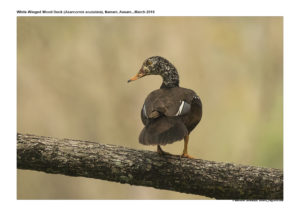White-winged-wood-duck

White-winged wood Duck Asarcornis scutulata
Etymology:
- Asarcornis : Greek Word asarkos without flesh; ornis bird
- Scutulata : Latin word for scutula- diamond-shaped
Vernacular Names: Ass: Deo hanh, Cachar: Hagrani, Daophlantu
Distribution in India: Resident of North East India. It is the State bird of Assam
Description: Size of 66-81 cm. Has a white head and neck, variably spotted black especially on crown to hind neck, chestnut-brown lower underparts, black glossed metallic green neck, mantle, rump and upper tail-coverts; underwing largely white. Upper wing-coverts, except greater coverts, white with greenish-black tips, and secondaries bluish-grey, primaries black, tertials white fringed black, and tail dark brown. No eclipse plumage. Bare parts: bill lemon-yellow to rich orange mottled black over base and tip which in male base becomes swollen in breeding season. The legs and feet are lemon-yellow to orange-yellow mottled greenish, irides orange-yellow to red. The female is smaller than male, with heavier blackish spotting on head; brownish iris.
Habitat: It is found in undisturbed, secluded pools and marshes in dense, freshwater and peat swampy forest, including partially logged areas, but also sometimes visits rice paddies to feed, jungle pools (natural depressions, ditches, small reservoirs etc.), sluggish channels, river pools, secluded bheels.
Food Habits: It eats seeds and green parts of various aquatic plants, grain, rice, Molluscs, insects, spiders and small vertebrates like fish and amphibians. Feeds chiefly by dabbling and head dipping in shallow water; also dives occasionally. Sometimes feeding at night mainly if moonlit, also very active around dawn and dusk.
Breeding Habits: They breed from April- July in North East India. They nest in tree hollows above ground and typically over open water, sometimes in old nests of other birds or on ground on stream bank below large fallen log or among dense stand of reeds. The nest is lined with leaves, grasses and roots of water hyacinth .They lay a clutch of 6–15 eggs . The incubation period is 33–35 days by female alone, which departs nests twice per day, although male remains in close attendance and escorts female during feeding bouts. The duckling are precocial, and is tended by both parents. The fledging period is 14 weeks and young may remain with parents thereafter for another 3–5 weeks.